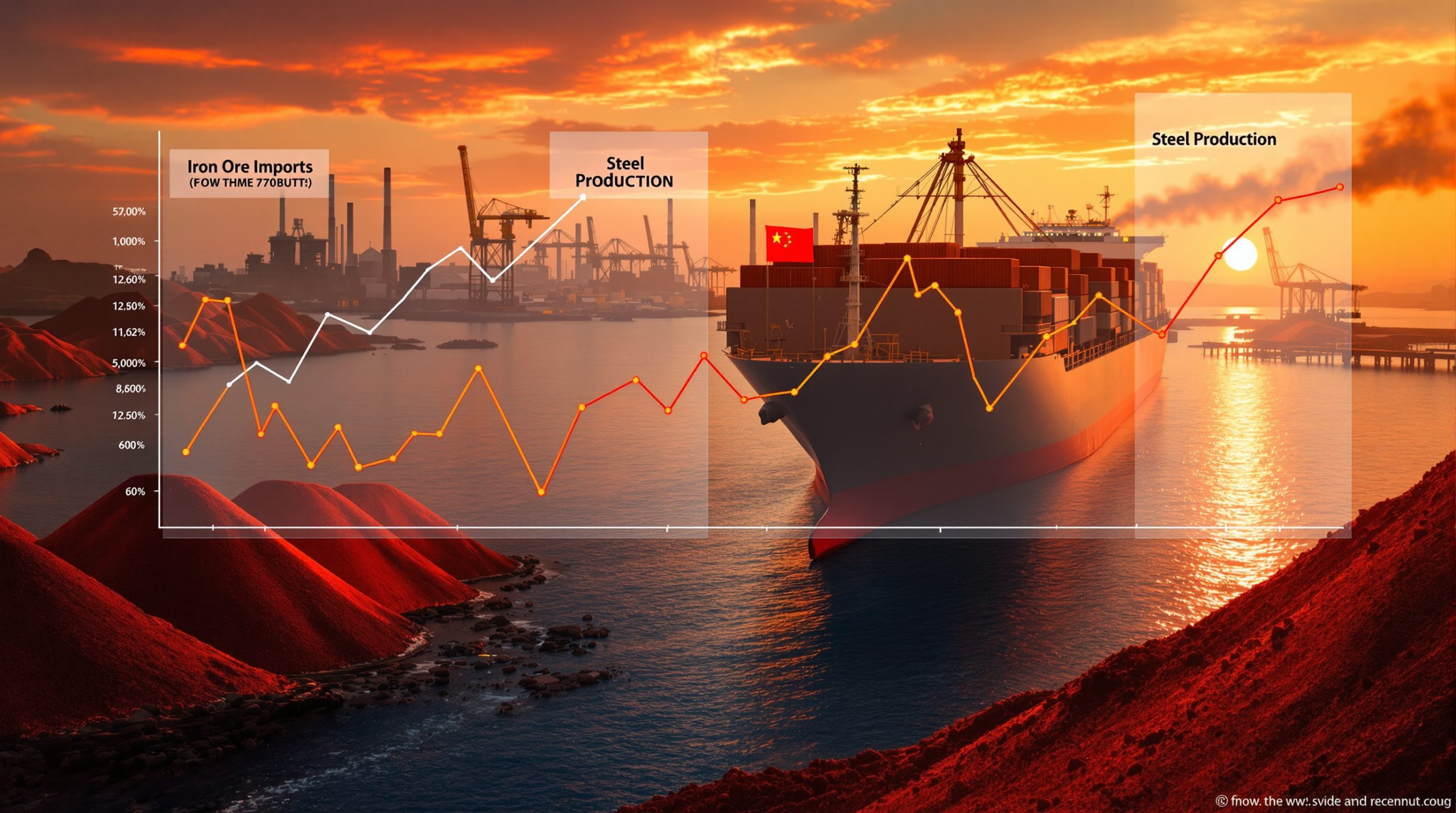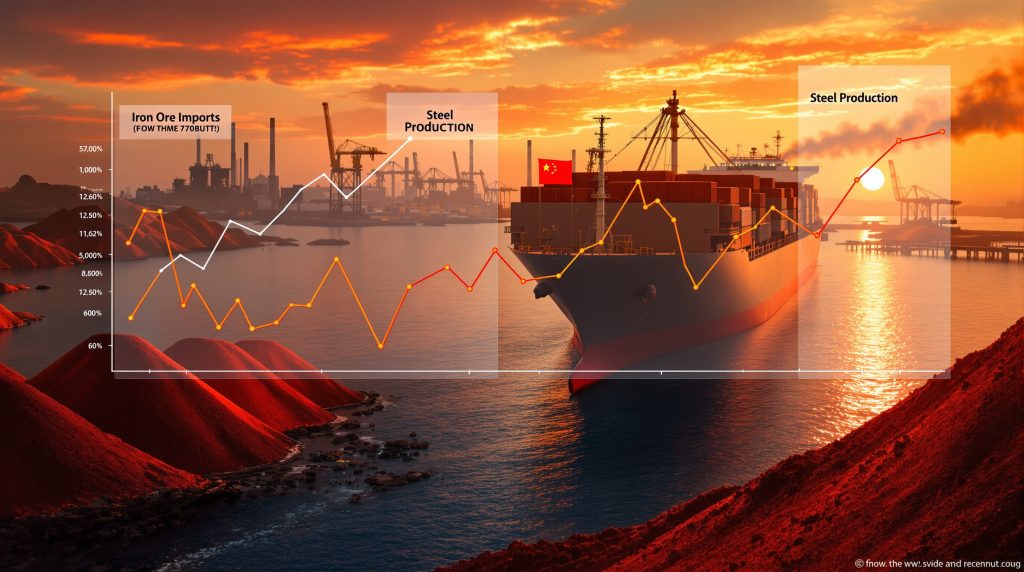Understanding China's Iron Ore Import Paradox: Rising Imports Despite Falling Steel Production China's iron ore imports have shown remarkable resilience in 2025, maintaining robust volumes despite weakening domestic steel production. This divergence creates a fascinating market paradox that impacts global commodity markets and pricing. Key Import Statistics for 2025 August 2025 saw imports of 105.23 million tons, marking the third consecutive month above 100 million tons. This sustained import strength comes at a time when domestic steel production has been noticeably contracting. September 2025 projections by Kpler indicate potential imports of 112.2 million tons, which would represent the highest monthly total since December 2024. If achieved, this would further widen the disconnect between raw material acquisition and finished steel output. Year-to-date imports through August 2025 remain strong despite a 2.8% decline in domestic steel production over the same period compared to 2024, highlighting the unusual nature of China's current import strategy. Price Movements and Market Response Iron ore benchmark futures on the Singapore Exchange reached $105.50 per ton in mid-September 2025, just below the six-month high of $106.75 recorded on September 9. This price strength reflects robust Chinese buying despite bearish indicators from the steel sector. Prices have rallied 13% from the yearly low of $93.35 recorded on July 1, 2025, demonstrating remarkable resilience in the face of contracting steel production and weak construction activity. The market has shown a strong disconnect between fundamental steel demand indicators and raw material pricing, suggesting factors beyond immediate consumption needs are driving purchase decisions. Why Is China Importing More Iron Ore While Producing Less Steel? The disconnect between China's steel production and iron ore imports represents a strategic calculation by Chinese mills and traders, driven by several interconnected factors. Optimism About Government Stimulus Steel mills continue purchasing iron ore in anticipation that Beijing's stimulus measures for construction sectors will eventually boost demand. This represents a forward-looking stance rather than a reaction to current market conditions. This optimism persists despite limited evidence of stimulus effectiveness so far, with housing prices continuing their downward trend and construction starts remaining weak. Mills are positioning themselves to quickly ramp up production when stimulus effects materialize, ensuring they have sufficient raw material inventory to capitalize on demand recovery without facing supply constraints. Strategic Stockpiling Behavior Port inventories rose to 132.6 million tons by mid-September 2025, though still below the 149.4 million tons recorded in the same period a year earlier. This measured increase suggests a deliberate inventory building strategy rather than panic buying. This strategic buildup serves as a buffer against potential supply disruptions, reflecting lessons learned from previous supply chain challenges and price volatility episodes. Lower inventory levels compared to previous years suggest room for continued stockpiling without reaching excessive levels that might trigger price corrections. Price Arbitrage Opportunities Periodic dips in iron ore prices have triggered opportunistic buying by mills and traders seeking to capitalize on favorable price points. This speculative element adds volume to imports even when immediate consumption needs don't justify the purchases. Mills and traders capitalize on price volatility to secure supplies at favorable rates, viewing temporary price weakness as buying opportunities rather than warning signals. This speculative element contributes to import volume stability even as steel output declines, creating a floor for both import volumes and global iron ore prices. How Has China's Steel Production Changed in 2025? China's steel sector has experienced notable contraction in 2025, influenced by both market forces and policy directives. Production Decline Metrics August 2025 steel output fell to 77.37 million tons, the lowest monthly total since December 2024. This represents a 0.7% year-on-year decline and a 2.9% drop from July 2025's production of 79.66 million tons. Cumulative production for the first eight months of 2025 reached 671.81 million tons, down 2.8% from the same period in 2024, indicating a sustained slowdown rather than a temporary adjustment. The declining production trend has persisted for three consecutive months, signaling a structural shift rather than seasonal fluctuation. Factors Driving Steel Production Contraction Weakening profit margins for steel producers have reduced incentives for maintaining high production levels, with many mills choosing to limit output rather than operate at a loss. Soft demand from key steel-consuming sectors, particularly construction, has failed to provide the volume support needed to justify higher production rates. Production curbs related to environmental policies have played a role, including temporary restrictions during Beijing's military parade in early September 2025, which contributed to the weak August output figures. Potential informal government targets capping annual production around 1 billion tons, similar to levels maintained over the past five years, create a ceiling for total annual output regardless of market conditions. Production Outlook for Late 2025 Potential production recovery is expected in September following the lifting of temporary environmental restrictions imposed for Beijing's military parade commemorating the end of World War Two. Remaining production capacity of approximately 328 million tons for the final four months of 2025 (averaging 82 million tons monthly) exists if producers aim to stay within the informal annual cap of 1 billion tons. Steel rebar inventories of 4.69 million tons (as of mid-September) remain below seasonal norms, suggesting potential for production increases without creating inventory overhang. What's Happening in China's Construction Sector? The construction industry, traditionally China's largest steel consumer, continues to face significant headwinds that impact the broader steel demand picture. Real Estate Market Indicators New home prices decreased 0.3% in August 2025 from the previous month, extending a downward trend that began in May 2023. This persistent weakness contradicts the optimistic purchasing behavior of steel mills. This represents a prolonged correction phase rather than a temporary adjustment, with over two years of consecutive monthly price declines pointing to structural issues in the property market. New construction starts plummeted 19.5% in August 2025 compared to the same month in 2024, indicating developers remain hesitant to launch new projects despite government encouragement. Impact on Steel Consumption Reduced residential construction activity directly translates to lower steel demand, as reinforcing bar, structural steel, and other construction materials make up a significant portion of total steel consumption. Infrastructure projects have not fully offset the real estate sector's contraction, creating a persistent demand gap that explains the production decline despite strong China iron ore imports. The disconnect between construction activity and iron ore imports suggests mills are preparing for future demand rather than responding to current needs, essentially betting on a market recovery. Government Intervention Efforts Beijing has implemented various stimulus measures targeting construction sectors, though evidence of their effectiveness remains limited based on continued weakness in housing prices and new starts. Results have been mixed, with limited impact on reversing the real estate market decline despite policy efforts to support the sector. Steel mills continue importing iron ore in anticipation that these measures will eventually gain traction, representing a vote of confidence in government policy effectiveness even as current indicators remain weak. How Does China's Iron Ore Buying Affect Global Markets? As the dominant buyer in the seaborne iron ore market, China's import decisions reverberate throughout the global supply chain. China's Market Dominance China accounts for approximately 75% of global seaborne iron ore trade, giving its purchasing patterns extraordinary influence over global market dynamics. This concentration gives Chinese buying patterns outsized influence on global pricing, with even modest changes in Chinese import volumes or inventory strategies capable of moving markets significantly. Major suppliers structure their operations around China demand prospects, with production plans, expansion decisions, and marketing strategies heavily influenced by Chinese market signals. Impact on Global Pricing Strong Chinese imports have supported global iron ore prices despite bearish fundamentals in the steel sector, creating a disconnect between raw material and finished product markets. The price rally from July to September 2025 directly correlates with sustained Chinese buying despite weak construction indicators and falling steel production. This creates a potential vulnerability if Chinese imports suddenly decrease, as the market has become dependent on continued strong purchasing despite weak consumption fundamentals. Supply Chain Implications Major producers continue investing in capacity expansions based on Chinese import resilience, potentially creating future oversupply risks if Chinese demand patterns shift. Shipping routes and logistics remain heavily oriented toward China-bound cargoes, with freight rates and vessel positioning strategies closely tied to Chinese import patterns. Market participants closely monitor Chinese port inventories and steel mill purchasing patterns as leading indicators, often prioritizing these signals over broader economic indicators when making trading decisions. What Are the Projections for China's Iron Ore Imports? Looking ahead, several factors will determine whether China's robust iron ore imports will continue or face adjustment. Short-Term Outlook (Q4 2025) September 2025 imports are projected to reach 112.2 million tons according to Kpler forecast, potentially marking the highest monthly total since December 2024. Potential for continued strong imports through Q4 exists if steel production recovers seasonally after the temporary environmental restrictions are lifted. Inventory building likely to continue while prices remain relatively stable, with mills using the final months of 2025 to position themselves for potential demand recovery in early 2026. Medium-Term Considerations (2026-2027) Government policies regarding steel production caps will significantly impact import volumes, with any adjustment to the informal 1 billion ton annual ceiling having direct implications for raw material needs. Real estate sector recovery timeline remains uncertain, with sustained weakness potentially leading to a reassessment of raw material procurement strategies if stimulus measures continue to show limited effectiveness. Infrastructure stimulus effectiveness will influence steel demand and, consequently, iron ore demand insights, with successful project acceleration potentially supporting continued strong imports despite real estate weakness. Structural Shifts to Monitor China's push toward electric arc furnace steelmaking could gradually reduce iron ore dependence, as this technology primarily uses scrap steel rather than iron ore as its raw material input. Scrap steel utilization rates are increasing, potentially displacing some iron ore demand as China's domestic scrap generation grows and collection systems improve. Environmental policies may impose further constraints on blast furnace operations, potentially accelerating the transition toward less iron ore-intensive production methods. How Are Steel and Iron Ore Inventories Trending? Inventory levels provide crucial insights into market dynamics and future import patterns. Current Inventory Situation Iron ore port inventories reached 132.6 million tons by mid-September 2025, representing a strategic buildup but still below the 149.4 million tons recorded in the same period of 2024. This inventory level suggests mills are maintaining comfortable but not excessive raw material stocks, providing operational flexibility without creating significant price pressure. Steel rebar inventories stood at 4.69 million tons as of September 12, 2025, monitored by consultants SteelHome, indicating relatively balanced finished product supplies despite production cuts. Seasonal Patterns and Expectations Steel inventories typically build during winter months when construction activity slows, peaking in March before the spring construction season begins. Current rebar stockpiles (4.69 million tons) remain well below the March 2025 peak of 6.36 million tons and the March 2024 level of 8.37 million tons, indicating potential room for additional inventory accumulation. This seasonal pattern suggests the potential for continued steel production and associated raw material consumption even with current demand weakness, as mills prepare for anticipated seasonal demand patterns. Strategic Implications Lower-than-normal inventories provide justification for continued strong imports, as mills can point to relative inventory discipline when making the case for maintaining raw material purchases. Mills may be positioning for potential supply disruptions or price increases, using the current period of relative price stability to build strategic reserves. The inventory situation supports the case for sustained import volumes despite weak current consumption, as both mills and traders perceive current stock levels as providing insufficient buffer against potential market changes. What Does This Mean for Global Iron Ore Producers? The resilience of China's iron ore imports creates both opportunities and challenges for global producers. Producer Response to Chinese Demand Major producers maintain production rates despite steel sector weakness, focusing on China's apparent willingness to continue purchasing rather than responding to downstream steel market signals. Investment decisions continue to be heavily influenced by Chinese import patterns, with capacity expansion plans often justified by projections of continued Chinese demand growth despite current market challenges. Supply discipline remains important to balance market fundamentals, with producers needing to carefully calibrate output to avoid undermining the price support provided by strong Chinese imports. Pricing Strategy Considerations Producers benefit from China's strategic stockpiling behavior, which provides a floor for prices even during periods of weak steel production and consumption. Price volatility creates opportunities for flexible marketing approaches, allowing producers to optimize sales timing and contract structures. Long-term contract structures continue to evolve in response to market dynamics, with producers seeking to balance volume security against pricing flexibility. Diversification Efforts Producers increasingly seek to develop markets outside China to reduce dependency on a single dominant customer, though progress remains challenging given China's outsized market share. Product quality differentiation becomes more important as Chinese mills become more selective, focusing on iron content, impurity levels, and physical characteristics that optimize blast furnace performance. ESG considerations gain prominence in marketing strategies to Chinese buyers, as environmental performance becomes increasingly important in procurement decisions. FAQ: China's Iron Ore Import Dynamics Why are China's iron ore imports rising while steel production falls? Chinese mills are purchasing iron ore based on expectations of future demand recovery, strategic stockpiling considerations, and opportunistic buying during price dips. This reflects both optimism about government stimulus measures and a desire to secure supplies at favorable prices. What is China's annual steel production target? While not officially stated, industry analysts believe Beijing maintains an informal target of keeping annual steel production around 1 billion tons, similar to levels seen over the past five years. This policy aims to control industrial capacity and emissions. How much of global iron ore trade does China control? China accounts for approximately 75% of global seaborne iron ore trade, making it the dominant force in determining market prices and supply-demand dynamics. This concentration gives Chinese purchasing decisions outsized influence on global markets. Will China's iron ore imports continue to grow in coming years? Long-term growth prospects are increasingly uncertain due to structural factors including the maturation of China's infrastructure development, emphasis on steel recycling, environmental policies, and the real estate sector's persistent challenges. Near-term imports remain robust despite these headwinds. How do iron ore prices respond to Chinese import patterns? Iron ore prices demonstrate high correlation with Chinese import volumes and port inventory levels. The recent price rally from July to September 2025 directly reflects sustained Chinese buying despite weak steel sector fundamentals, with iron ore price forecast models closely tracking these patterns. Further Exploration Readers interested in learning more about global iron ore markets can also explore the potential tariffs impact on iron ore and the various iron ore market types that shape global trade patterns. Disclaimer: This article contains forward-looking statements and market projections based on current data and analyst forecasts. Future market conditions may vary significantly from these projections. Readers should conduct their own research before making investment decisions based on this information. Are You Monitoring the Next Major Iron Ore Market Shift? Stay ahead of critical trends like China's paradoxical import strategy with real-time alerts from Discovery Alert's proprietary Discovery IQ model. Visit our discoveries page to understand how identifying key market shifts early can transform your investment returns in the resources sector.

China’s Iron Ore Imports Rise Despite Falling Steel Production
Discover why China’s iron ore imports stay strong despite falling



